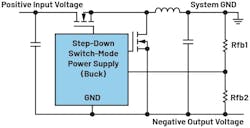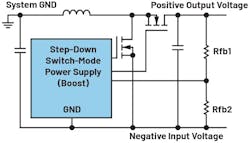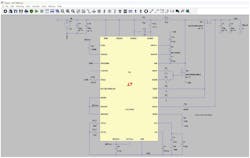How to Invert Voltages
What you'll learn:
- Setup for generating a negative voltage from an existing positive voltage.
- Setup for generating a positive voltage from a negative voltage.
Power converters are commonly used to generate a regulated supply voltage for a circuit from an existing voltage rail. In most applications, a voltage is lowered with a buck-converting switching regulator. Sometimes, though, a voltage is increased, which often happens with an upconverting boost converter. These two topologies, buck and boost, are used in a wide range of applications.
However, there are times when a voltage needs to be inverted. In most cases, a positive supply voltage must be converted into a negative voltage. This is necessary to supply sensors in the signal path to process a signal with positive and negative voltage deflection.
For example, +5 V and –5 V are used as the power supply for an op amp to process a signal voltage. Negative voltages are required in some applications to safely switch off the gates of MOSFETs.
To generate a negative voltage from an existing positive voltage, an inverting topology is suitable (Fig. 1). A positive voltage is transformed into a negative voltage. The circuit is simple, doesn’t require a transformer, and can be built with a standard buck switching-regulator IC. The output voltage of the buck regulator is connected to the system ground, and the GND pin voltage results in a negative voltage that can be adjusted with resistor divider Rfb1 and Rfb2.
Converting to a Positive Voltage
Sometimes the need arises to convert a negative voltage into a positive voltage. A common application is in the field of telecommunications, where –48 V must be converted to +48 V. There are also applications in the industrial sector.
>>Download the PDF of this article
An elegant solution for this requirement is available, and it doesn’t need a transformer. Figure 2 shows an inverting boost converter, which generates a positive voltage from a negative voltage. It doesn’t require a buck regulator, but rather a boost regulator IC. The power level must be designed in such a way that the respective body diodes of the switches are conducting in the right direction.
To convert a negative voltage into a positive voltage efficiently and with many features, additional components are necessary. For example, a level conversion is needed for different setting pins, such as a soft-start function or a clock synchronization function. The allowable voltage range on these pins depends on the GND pin of the switching-regulator IC, which is the negative input voltage.
For comfortable switching, even at higher power, a dedicated switching-regulator IC is suitable for voltage conversions from a negative voltage to a positive voltage. One such IC is the LTC7899, a switch-mode power-supply boost converter controller that’s specially designed for converting negative voltages to positive voltages. It uses external switches, works synchronously, and offers a high voltage range of up to 135 V between the input and output.
Figure 3 shows the LTC7899 in an inverting circuit in the simulation program LTspice, with which the circuit can be simulated.
Conclusion
Negative and positive voltages can also be easily inverted without a transformer. Many applications require such inversion. There are simple solutions and a wide selection of suitable power-converter ICs. However, to design a high-performance, easy-to-use circuit, special switching controllers, such as the LTC7899, are suitable.
>>Download the PDF of this article
About the Author

Frederik Dostal
Power-Management Technical Expert
Frederik Dostal is a power-management expert with more than 20 years of experience in this industry. After his studies of microelectronics at the University of Erlangen, Germany, he joined National Semiconductor in 2001, where he worked as a field applications engineer, gaining a lot of experience in implementing power-management solutions in customer projects. During his time at National, he also spent four years in Phoenix, Arizona (USA), working on switch-mode power supplies as an applications engineer.
In 2009, he joined Analog Devices, where since then he held a variety of positions working for the product line and European technical support, and currently brings in his broad design and application knowledge as a power-management expert. Frederik works in the ADI office in Munich, Germany.
Also check out my:




